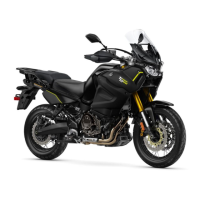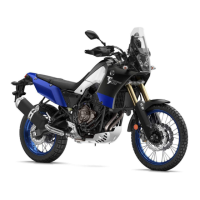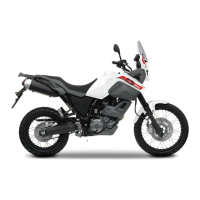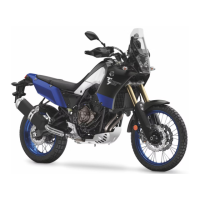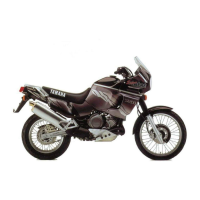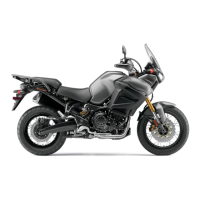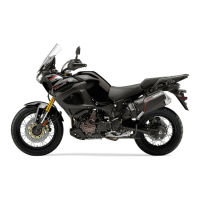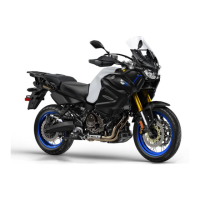
Do you have a question about the Yamaha Super Tenere ES 2023 and is the answer not in the manual?
| Displacement | 1199 cc |
|---|---|
| Bore x Stroke | 98.0 mm x 79.5 mm |
| Compression Ratio | 11.0:1 |
| Horsepower | 110 hp @ 7, 250 rpm |
| Transmission | 6-speed |
| Final Drive | Shaft |
| Rear Brake | 282mm hydraulic disc |
| ABS | Standard |
| Cruise Control | Standard |
| Lighting | LED |
| Engine Type | Liquid-cooled, DOHC, 2-cylinder |
| Fuel System | Fuel injection |
| Ignition | TCI (Transistor Controlled Ignition) |
| Front Suspension | 43mm inverted fork |
| Rear Suspension | Single shock |
| Front Brake | Dual 310mm hydraulic disc |
| Rear Tire | 150/70R17 |
| Fuel Capacity | 6.1 gallons |
| Instrumentation | LCD display |
| Rider Aids | Traction Control System |
Owner's responsibility for safe operation, including obtaining instructions and training.
Tips for safe riding, visibility, intersection awareness, and proper maintenance.
Guidelines on wearing helmets, eye protection, jackets, boots, and gloves.
Precautions against CO poisoning from engine exhaust in enclosed areas.
Advice on loading cargo and accessories, respecting weight limits and distribution.
Instructions for safely securing the motorcycle for transport in another vehicle.
Identifies key components visible from the left side of the motorcycle.
Identifies key components visible from the right side of the motorcycle.
Diagram showing the location of various controls and instruments on the handlebars.
Explains the functions of the main switch and how to lock the steering.
Describes the meaning and function of various indicator and warning lights.
Details the features and displays of the multi-function meter unit.
Identifies and explains the function of switches on both left and right handlebars.
Describes the Anti-lock Brake System (ABS) operation and features.
Explains the traction control system, its modes, and operation.
Instructions on how to remove, install, and adjust the rider seat height.
Guide to adjusting the electronically adjustable suspension preload and damping.
Instructions for using the 12-V accessory jack for external devices.
Explains the system that prevents starting with sidestand down or in gear.
Checks for fuel level, fuel line, and tank breather/overflow hoses.
Procedure for checking engine oil level and for oil leakage.
Instructions for checking coolant level and for cooling system leakage.
Checks for front/rear brake operation, pads, fluid level, and hydraulic system.
Checks for tire damage, condition, tread depth, and air pressure.
Verifying operation of all lights, signals, and switches.
Procedure for starting the engine, including safety interlocks and indicator lights.
Explanation of gear positions, shifting procedures for acceleration and deceleration.
Guidelines for the initial 1600 km (1000 mi) break-in period for engine longevity.
Description of the included tool kit and its purpose for maintenance.
Schedule for regular maintenance tasks, inspections, and lubrication points.
Procedure for checking spark plug condition, gap, and replacement.
Detailed steps for checking, changing engine oil, and replacing the oil filter.
Instructions for checking and changing the final gear oil level and quantity.
Procedure for checking coolant level and replacing the coolant.
Guidance on replacing the air filter element at specified intervals.
Details on tire inspection, air pressure, tread depth, and replacement.
Information on checking, charging, and storing the VRLA battery.
Steps for identifying and replacing blown fuses with correct amperage.
Guides for diagnosing starting problems or poor engine performance.
Steps for diagnosing and addressing engine overheating issues.
Recommendations for washing, cleaning, and polishing the vehicle.
Advice on protecting the vehicle from road salt and corrosion in winter.
Instructions for storing the vehicle in a cool, dry place, including long-term storage.
Technical specifications for vehicle dimensions, wheelbase, and weight.
Details on engine cycle, cooling, valve train, displacement, and gear ratios.
Recommended fuel type, tank capacity, and oil/coolant quantities.
Information on system voltage, battery model, and headlight/lighting types.
Location and importance of VIN, engine serial, model, and key identification numbers.
Identifies the location of the diagnostic connector for vehicle data access.
Procedure for reporting vehicle defects to NHTSA and Yamaha Motor Corporation.
Chart for recording maintenance intervals, dates, mileage, and dealer information.
Details of the Yamaha limited warranty, coverage periods, and exclusions.
Information on extended service plans to supplement the limited warranty.
